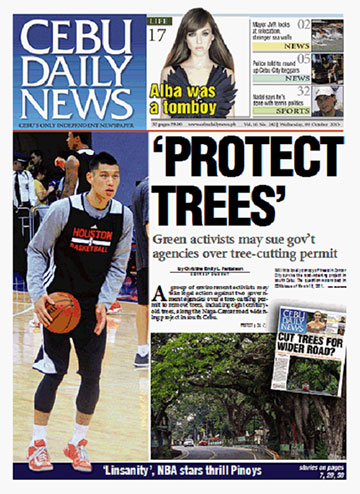Green activists may sue gov’t agencies over tree-cutting permit

“We are considering filing a case against them,” said lawyer Rose Liza Eisma-Osorio of the Philippine Earth Justice Center (PJEC) in an interview.
She said the Department of Public Works and Highways (DPWH) and Department of Environment and Natural Resources (DENR) should be held liable for allowing the road project to conitnue without exploring other options so as not to harm 154 trees along the 3.1 km highway from barangays Tinaan in Naga City to Langtad in Carcar City.
Work started in 2003 to build a four-lane highway to Carcar. The brainchild of then 1st district Rep. Eduardo Gullas is his legacy project, now continued by his grandson, Rep. Samsam Gullas.
Last month, the DENR central office issued a special tree-cutting permit for the DPWH to remove 42 trees, including eight century-old acacia trees which are standing in the way of the national road project.
This came despite objections raised since last year by heritage and environment lobbyists, including the Movement for a Liveable Cebu and former Cebu City Councilor Jack Jakosalem, whose father Dionisio Jakosalem was the Cebu governor who had many of the trees planted in 1915.
Article continues after this advertisementEarth-balling remains a costly option at P1.5 million per tree.
Article continues after this advertisementBecause of the heritage value of the older trees, the DPWH had to request permission from the DENR Secretary under Presidential Decree 953 and Executive Order 23.
Not all century-old narra trees will be removed.
Sixteen of them will remain in place and should only be rehabilitated, said DENR information officer Eddie Llamedo. They can’t be earth-balled or transferred under conditions of the permit.
He said PEJC is welcome to join in monitoring conditions required before the tree-cutting. The monitoring activity will be attended by DENR, DPWH and local government units (LGUs).
Llamedo said that out of the 154 trees along the highway, only 42 of them can be cut.
Another 96 trees with a diameter of 25 cm should be earthballed or uprooted and replanted in a different location. These include narra and avocado trees.
DPWH is required to take care of these trees for three years and maintain 80 percent survival rate. If a tree would die, it has to be replaced with 100 trees.
Only seven of the 24 acacia trees along the road can be cut because of its advanced state of deterioration while 16 should be kept in place.
Trees which can be cut down have a diameter of 26 cm. They were identified as bagalonga, bread fruit, gemilina, jack fruit, dul-dul, lanite, mahogany, mango, mansanitas, star apple, neem tree, talisay, taloot, tamarind and tambis.
Llamedo said 16 century-old acacia trees have to be maintained. DPWH is required to present another road-widening project design that does not affect them.
DPWH can only cut down acacia trees marked last May 2012 with the numbers 82, 86 87, 88, 110, 111, 112, 113.
One of these eight marked trees, already rotted due to disease, collapsed two months ago and almost hit a passing Ceres bus. The acccident tied up traffic in south Cebu for eight to 10 hours.
Llamedo said these old acacia trees were already in an advance state of deterioration and posed serious danger to life and properties.
However, Osorio of PEJC said the group still has to verify if these trees were really contaminated with disease and rotting.
“They knew in the first place that those trees exist. They should have explored options before they plan for their road widening project,” Osorio said.
She said the DPWH also started the road project before securing an Environmental Compliance Certificate.
DPWH-7 Regional Director Ador Canlas said his agency considered other options for the road-widening but they all involve cutting down the trees.
“There are really trees that will be affected in the alignment of the road-widening project. That is why it took us for more than a year to pursue the project,” he said.
The roadwork is being carried out by Adlawan Construction.
Canlas said that the agency is strictly complying with the conditions set by DENR before they could cut trees.
“We are not here to fight anybody. We are only here to comply with the project that we are working for,” Canlas said.
DENR set three conditions in the tree-cutting permit:
First, DPWH should get endorsements from barangays Langtad, Tinaan, and Inoburan in Naga City.
Second, DPWH should conduct a thorough study and assessment of biodiversity concerns and the impact of cutting of trees.
Third, DPWH should plant 13,800 indigenous native trees such as narra and mabolo as replacements.
In a previous interview, then Congressman Gullas, said his road project was intended to speed up economic activity in south Cebu.
“This road has a regional influence and that is the reason why as early as 1992, I envisioned a four-laned highway going to Carcar because Carcar now has a bypass road going to the next town,” Gullas said.
He observed that traffic is no longer well served by the existing two-lane road in south Cebu.
Canlas said DPWH will add three to four more lanes in the highway but that it will narrow the road to two lanes where the 16 century-old acacia trees are located.